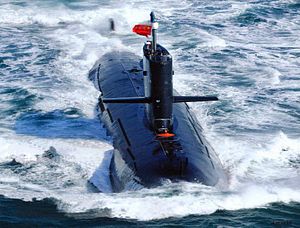The Chinese Navy in in the process of commissioning three new nuclear-powered attack submarines, according to China Daily. The report, quoted on the website Defense Tech, furthermore notes that the new vessels will be equipped with a new vertical launching system capable of firing supersonic anti-ship missiles.
The “new” SSNs are in fact, upgraded versions of the Type-093 Shang-class second-generation nuclear-powered attack submarines, two of which are currently in service in the People’s Liberation Army Navy. The upgrades are designated Type-093G.
“The Type-093G is reported to be an upgraded version of Type-093… With a teardrop hull, the submarine is longer than its predecessor and has a vertical launching system,” China Daily said.
However, the Chinese PLAN could also choose to re-designate the ships as Type-095 SSGNs, should all public reports on the vessel prove accurate.
Next to improved speed, reduced noise, and an increased operational range, the upgraded Type-093G Shang-class will be able to fire China’s most modern supersonic anti-ship missile, the YJ-18, the report states. There is sparse open source information available on this new missile, which is specifically designed to defeat the Aegis Combat System.
Nevertheless, writing on an older variant of the YJ-18, the YJ-12 ASCM, an analyst notes that it is, “the most dangerous anti-ship missile China has produced thus far, posing an even greater risk to the U.S. Navy’s surface forces in the Western Pacific than the much-discussed DF-21D anti-ship ballistic missile.”
The missile, he continues, has “a range of 400 kilometers, making it one of the longest-ranged ASCMs ever fielded (and much longer than the 124 kilometer limit of the U.S. Navy Harpoon).” According to some reports, YJ-12 boasts a speed of up to Mach 3 and can perform evasive maneuvers in air before hitting the target. Writing on an air-attack scenario the analyst points out what potentially could make the YJ-12 a “carrier killer” — its range and speed:
Crucially, at 400 kilometers, Chinese attack aircraft will be able to launch the YJ-12 beyond the engagement range of the Navy’s Aegis Combat System and the SM-2 surface-to-air missiles that protect U.S. aircraft carrier strike groups. (…) The YJ-12s would employ a variety of sensor types to find their targets and execute dramatic cork-screw turns to evade final defenses.
Despite a reduced range, the vertically launched YJ-18 otherwise may share similar characteristics with the YJ-12 and will be a deadly addition in any carrier strike group attack scenario. One public source describes the capabilities of the YJ-18:
After the vertical launch the missile’s turbojet engine is capable of flying at a cruise speed of Mach 0.8 for about 180 kilometers; after that point the warhead section separates and a solid rocket engine ignites allowing at a top speed of Mach 2.5-3 for about 40 kilometers (…) The missile can maneuver at 10G acceleration to avoid enemy interception by air-to-air or surface-air missiles.
Of course, the U.S. Navy is slowly adding new missile defense capabilities (e.g., Cooperative Engagement Capability) to its fleets along with new operational doctrines (see: “The Pentagon Just Dropped the Air Sea Battle Name”). However, multiple launch platforms make it more likely that the percentage of missiles penetrating the multi-layered defense perimeters of carrier strike groups will increase.
The Type-093G Shang-class are technologically on par with 1980s NATO nuclear-powered fast-attack submarines (i.e. roughly three decades behind current Western sub technology), according to some experts. The Taiwanese media reports that the upgrades on two Type-093G Shang-class subs were completed in December 2014 by the Bohai Shipyards in Huludao, while a third vessel is still in a dry dock.
However, Defense Tech reports that earlier this week, China Central Television showed satellite pictures claiming that the three vessels shown on photographs during the broadcast were, in fact, Type-093G attack submarines, anchored at an undisclosed Chinese harbor.

































